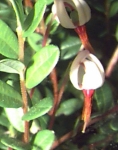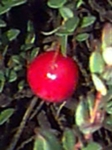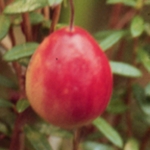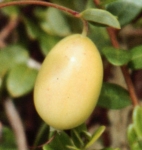| Taxonomy |
American Cranberry Vaccinium macrocarpon Ait. ERICACEAE (Heath Family) |
 |
| Etymology |
Vaccinium, the ancient Latin name for bilberry; macrocarpon means large-fruited, from the Greek: macro = long or large + carpa = fruit. |
|
| Synonyms |
Large Cranberry, Marshberry, Sourberry, Bounceberry |
|
| Description |
American Cranberry is a low, trailing, evergreen shrub that forms dense mats. Along with blueberry (Vaccinium corymbosum) and grape (Vitis labrusca), American Cranberry is one of three fruits native to New England that have been cultivated successfully. Cultivars of V. macrocarponare the staple of the cranberry industry, but the "ruby of the bog" still grows wild in natural peatlands. Cranberry flowers resemble the head and neck of a crane. Hence, the name cranberry comes from "crane's berry." |
 |
| Wetland indicator status |
OBL |
|
| Plant Height |
4-12 inches |
|
| Leaves |
Evergreen, alternate, simple, entire, 1/4 - 3/4" long; oblong to elliptical, rounded tip; leathery; shiny, dark green above; underside is pale; maroon-brown in winter. |
|
| Flower/Inflorescence |
Pale pink, small (1/2"); long orange stamens and red style protrude "beaklike" from the center of four recurved petals; single or in pairs on slender stalks that arise from mid- to lower leaf axils of the upright branches. |
 |
| Flowering Period |
June-August |
|
| Fruit |
Berry, bright red, 1/2-7/8" wide; shape varies: round, pear-shaped or oval-oblong; edible, tart -- the cultivated cranberry. |
   |
| Fruiting Period |
September-November |
|
| Habitat |
bogs, acidic peatlands, interdune swales |
|
| Range |
Newfoundland to Manitoba; south to Virginia, Illinois, Wisconsin and Minnesota; mountains to North Carolina and Tennessee. |
|
| Associates |
|
|
| Similar Species |
- Small Cranberry (Vaccinium oxycoccus) grows in more acidic, nutrient-poor habitats amd has smaller leaves and berries than American Cranberry. The leaves of Small Cranberry have white undersides, pointed tips and inrolled margins. The leaf tips of American Cranberry are rounded and the margins are flat. Another good diagnostic is location of the flower/fruit stalks: on American Cranberry, the stalks arise from mid-branch; on Small Cranberry, the stalks are at the tip of the branch.
- Creeping Snowberry (Gaultheria hispidula) has small, white flowers and berries.
|
 |
| Seasonal Diagnostics |
- Spring: Pink flowers in June and July
- Summer: Pale green unripe berries.
- Fall: Ripe, bright or dark red berries that persist into winter.
- Winter: Evergreen leaves turn maroon-brown.
|

Winter |







